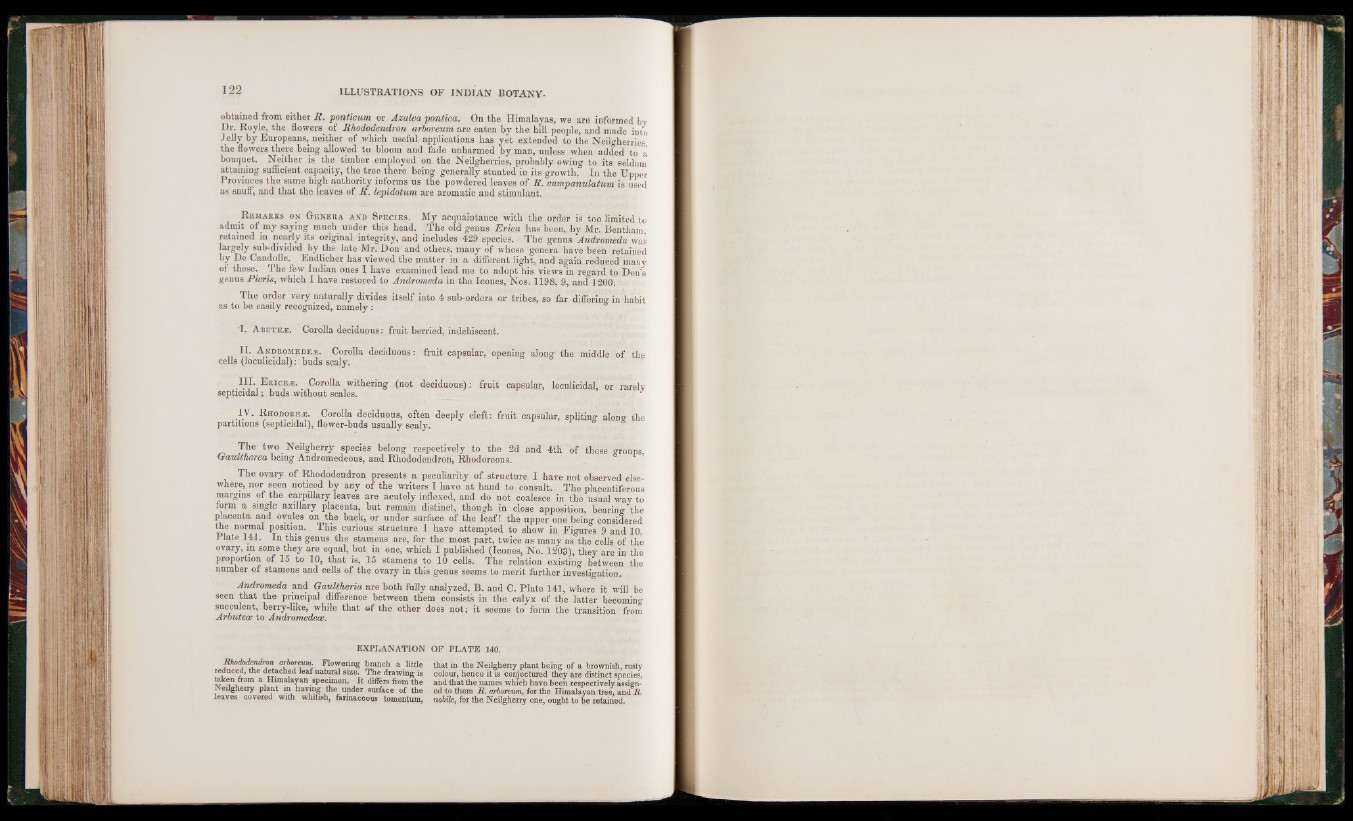
obtained from either R. ponticum or Azalea pontica. On the Himalayas, we are informed by
Dr. Royle, the flowers of Rhododendron arboreum are eaten by the hill people, and made into
Jelly by Europeans, neither of which useful applications has yet extended to the Neilgherries
the flowers there being allowed to bloom and fade unharmed by man, unless when added to a
bouquet. Neither is the timber employed on the Neilgherries, probably owing to its seldom
attaining sufficient capacity, the tree there being generally stunted in its growth. In the Upper
Provinces the same high authority informs us the powdered leaves of R. campanulatum is used
as snuff, and that the leaves of R. lepidotum are aromatic and stimulant.
R emarks on Genera and Species. My acquaintance with the order is too limited to
admit of my saying much under this head. The old genus Erica has been, by Mr. Bentham,
retained in nearly its original integrity, and includes 429 species. The genus Andromeda was
largely sub-divided by the late Mr. Don and others, many of whose genera have been retained
by De Candolle. Endlicher has viewed the matter in a different light, and again reduced many
of these. The few Indian ones I have examined lead me to adopt his views in regard to Don’s
genus Picris, which I have restored to Andromeda in the leones, Nos. 1198, 9, and 1200.
The order very naturally divides itself into 4 sub-orders or tribes, so far differing in habit
as to be easily recognized, namely: e
T. Abute^e. Corolla deciduous: fruit berried, indehiscent.
II. A ndromede^e. Corolla deciduous: fruit capsular, opening along the middle of the
cells (loculicidal): buds scaly.
• ®RICE/E*. Corolla withering (not deciduous): fruit capsular, loculicidal, or rarely
septicidal; buds without scales. .
IV. R hodore^e. Corolla deciduous, often deeply cleft: fruit
partitions (septicidal), flower-buds usually scaly.
capsular, spliting along the
The two Neilgherry species belong respectively to the 2d and 4th of these groups
Gaultherea being Andromedeous, and Rhododendron, Rhodoreous.
The ovary of Rhododendron presents a peculiarity of structure I have not observed elsewhere,
nor seen noticed by any of the writers I have at hand to consult. The placentiferous
margins of the carpillary leaves are acutely indexed, and do not coalesce in the usual way to
form a single axillary placenta, but remain distinct, though in close apposition, bearing the
placenta and ovules on the back, or under surface of the leaf! the upper one being considered
the normal position. This curious structure I have attempted to show in Figures 9 and 10,
Plate 141. In this genus the stamens are, for the most part, twice as many as the cells of the
ovary, in some they are equal, but in one, which I published (leones, No. 1203), they are in the
proportion of 15 to 10, that is, 15 stamens to 10 cells. The relation existing between the
number of stamens and cells of the ovary in this genus seems to merit further investigation.
Andromeda and Gaultheria are both fully analyzed, B. and C. Plate 141, where it will be
seen that the principal difference between them consists in the calyx of the latter becoming
succulent, berry-like, while that of the other does not; it seems to form the transition from
Arbutece to Andromedece.
EXPLANATION OP PLATE 140.
Rhododendron arboreum. Flowering branch a little
reduced, the detached leaf natural size. The drawing is
taken from a Himalayan specimen. It differs from the
Neilgherry plant in having the under surface of the
leaves covered with whitish, farinaceous tomentum,
that in the Neilgherry plant being of a brownish, rusty
colour, hence it is conjectured they are distinct species,
and that the names which have been respectively assigned
to them R. arboreum, for the Himalayan tree, and R.
nobile, for the Neilgherry one, ought to be retained.